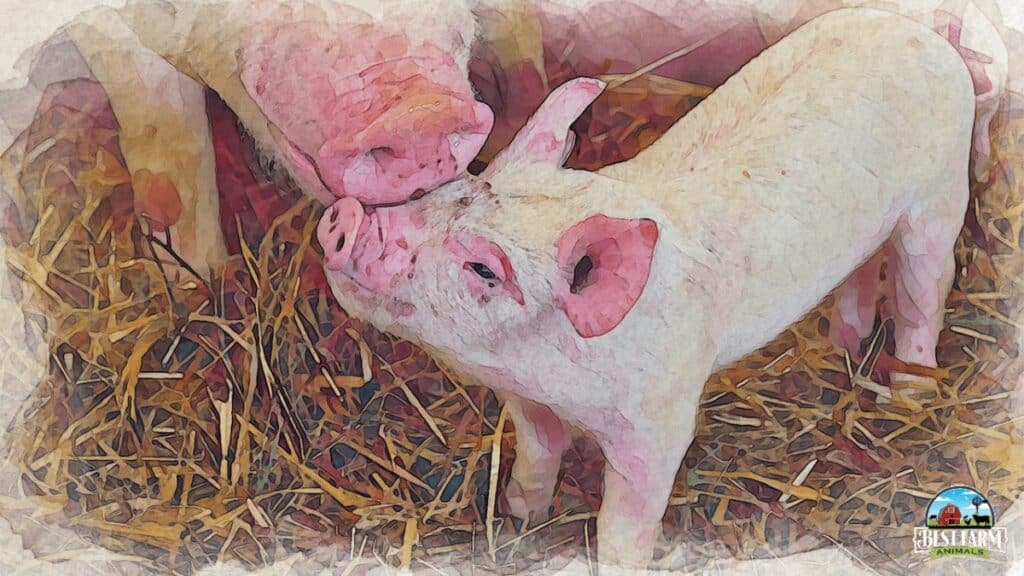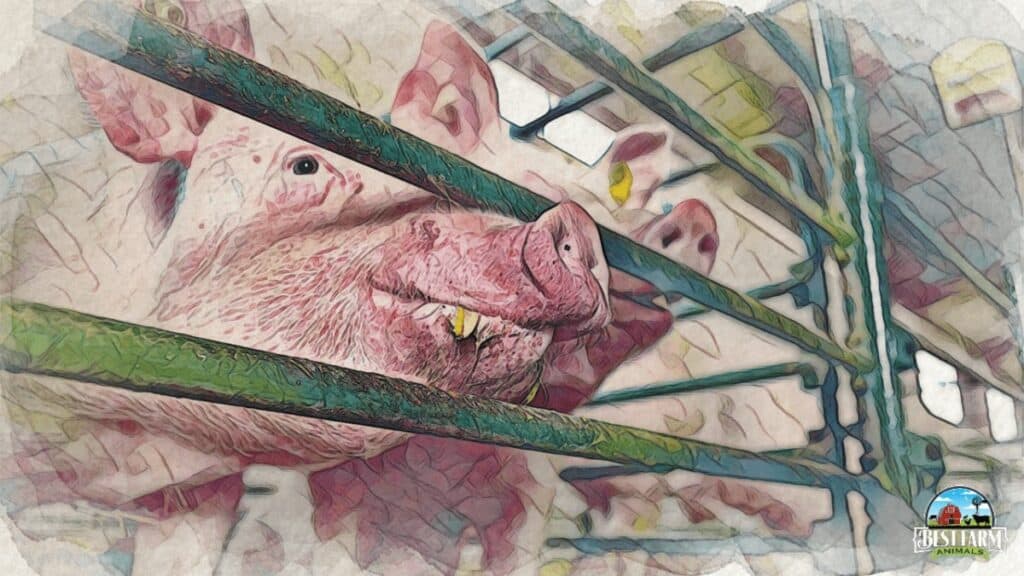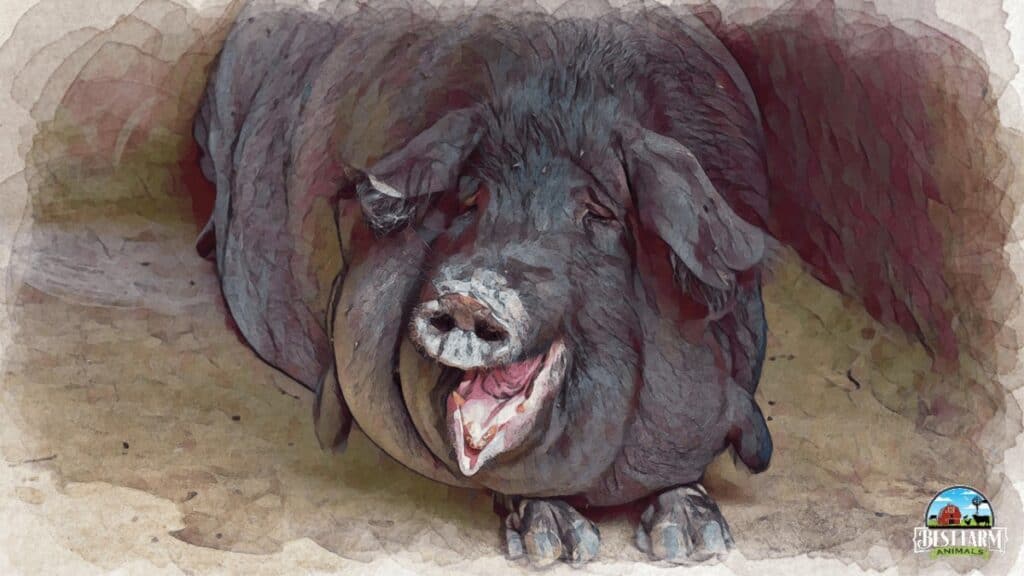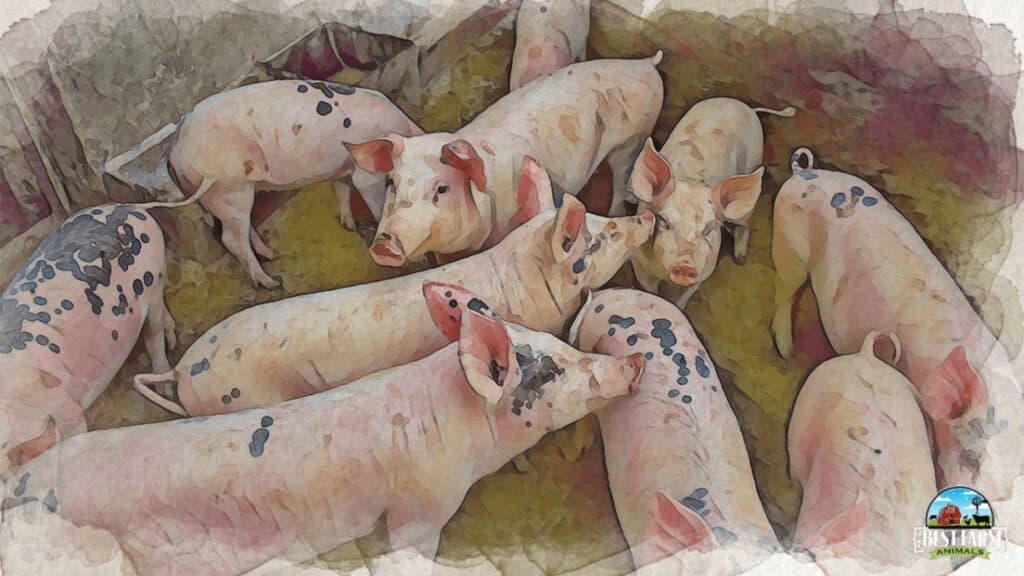The other day three of my pigs started coughing. It made me nervous because of the deep, racking coughs that came out. Since I take care to practice good husbandry, I was fairly certain it wasn’t a parasite and started looking into the various pig viruses and bacteria that cause a deep, dry pig cough.
What causes coughing in pigs? Pig cough is often caused by respiratory viruses or bacterial infections that infect the lungs, respiratory tract, and lining. As the pig’s immune system struggles to fight the virus, coughing often arises as a primary symptom. Circovirus, PRRS, Influenza, and Aujesky’s disease are the most common pig viruses that cause coughing and breathing difficulties.
Fortunately, there are steps you can take to help your pig get better and to stay healthier in the future. Let’s dive in.
Respiratory Viruses Can Cause Pig Cough And Spread Quickly
For the most part, pig viruses are highly contagious and can spread quickly among the herd. If you suspect one of your pigs is getting sick and as soon as you notice odd breathing patterns, coughing, or wheezing, separate the sick pig to avoid the spread of sickness. Two main classes of pig viruses exist those that infect many pigs quickly and are easily recoverable, and those that affect many pigs quickly, but are hard to recover from.
4 Respiratory Viruses that infect Pigs
Pigs cough for many reasons including common respiratory viruses that cause coughing, sneezing, and odd breathing. Porcine Circovirus, Blue Ear Disease, Influenza, and Aujeszky’s Disease are viruses that more commonly infect pig’s respiratory tracts and cause breathing issues.
1. Porcine Circovirus Results to Pig Coughing And Not Eating
Porcine Circovirus is a viral disease that primarily affects domestic pigs, resulting to pigs coughing and losing their appetite. Pigs with PCVD also have stomach ulcers, breathing difficulties, experience diarrhea, lethargy, and enlarged lymph nodes. The most common visual symptom of this infection is pale skin with purple blotches in pigs.
Commonly found in piglets and young pigs (between 2 and 4 months old), the PCVD virus attacks your pig’s immune system and leaves your pig vulnerable to other porcine diseases. Pigs infected with PCVD struggle to gain weight and appear very weak and may lead to death in severe cases. Pits with PCVD appear to waste away until they die.
The Porcine Circovirus disease is transmitted and shed through secretions such as blood, urine, feces, mucus, and saliva. Direct contact with an infected pig allows the virus to spread rampantly. The virus can also spread on your clothing, equipment, and shoes.
Unfortunately, there is no cure or specific treatment for PCVD. Vet may prescribe anti-inflammatory agents and antimicrobials to help ease the unpleasant symptoms on pigs. However, sometimes the only way to prevent the further spread of the disease is to euthanize the infected pig.
Symptoms of Porcine Circovirus Disease
The symptoms of porcine circovirus disease are:
- Coughing fits
- Breathing difficulties
- Diarrhea
- Pale skin with purple blotches
- Obviously enlarged lymph nodes
- Stomach ulcers
- Lethargy
- Loss of appetite

Preventing Porcine Circovirus Disease in Pigs
Discuss appropriate vaccination programs with your vet, such as Fostera Gold PCV, which will provide up to four months of immunity. Fostera Gold PCV MH is a long-acting vaccination and protect pigs for up to 23 weeks.
Adopt the All-In-All-Out management system.
Keep your pig’s environment hygienic and regularly disinfect the area.
Wash your clothing, shoes, and equipment thoroughly.
2. Porcine Reproductive and Respiratory Syndrome Causes Diarrhea
Porcine reproductive and respiratory syndrome, otherwise known as “blue ear disease,” may cause pig diarrhea. It is a common viral disease that affects domestic pigs of all ages with symptoms like pneumonia, fever, pig cough, red skin discoloration, and listlessness. PRRS destroys your pig’s defense mechanism, which causes secondary infections such as swine influenza.
If left untreated, this disease can be fatal. Some of the causes of porcine reproductive and respiratory syndrome are direct nose-to-nose contact and secretions. Pigs inside overpopulated living areas and injected with contaminated needles may also result in this disease. Even biting insects like flies and ticks can be the cause of PRRS.
This disease has a massive negative effect on the US swine production market and costs the industry over $650 million annually, which is why it’s important to report to authorities once the disease is confirmed.
Causes of PRRS
This particular virus can spread in several ways, such as:
- Direct nose-to-nose contact
- Through secretions such as feces, blood, mucus, semen, and urine
- Vectors (biting insects) such as flies and ticks
- Over-populated living areas
- The virus passes from the sow to her piglets
- Contaminated needles
- Transmitted through the air (up to 2 miles)
Symptoms of PRRS
These are the most common symptoms of PRRS:
- Pneumonia
- Reproductive failure
- Fever
- Excessive diarrhea
- Coughing
- Red skin discoloration
- Listlessness
Treating And Preventing Porcine Reproductive and Respiratory Syndrome in Pigs
As no medication is available to treat this virus, you’ll need to provide treatment to prevent secondary infections. Antibiotic treatment is given to sows and boars for three to four weeks (as soon as they have been diagnosed).
Add antibiotics to your pigs’ feed and water to help against PRRS. This measure should prevent stillbirths, mummified piglets, and abortions.
Provide your pigs with electrolytes to avoid dehydration and keep them warm.
Inject pigs with Amoxicillin or Oxytetracycline as most common used treatment for piglets.
Ensure administration of regular vaccinations.
Quarantine the infected herd and avoid buying new pigs until the disease is gone.
Consult your vet for a control plan to build herd immunity.
Remove any carcasses and waste from infected and diseased pigs, and disinfect your pigs’ living environment.

3. Swine Influenza Causes Coughing Pigs And Runny Nose
Swine influenza or flu is a highly contagious type A influenza virus that causes respiratory disease in pigs. A pig with this disease shows symptoms like pig coughing, runny nose, sneezing, lethargy and weight loss. Due to the cough, the pig may also have labored breathing, discharge from the eyes, and red and irritated eyes.
Sometimes, swine influenza strains show little or no symptoms. It is thus important to check on your pigs regularly to ensure that all of them are healthy.
Swine flu is highly contagious in pigs and can spread through direct contact with infected pigs. An infected pig sheds the virus through feces, mucus, urine, and blood for about seven to 10 days. Healthy pigs may inhale the contaminated droplets and become infected with the virus, so it’s important to quarantine pigs once affected
Swine flu also spread through objects, shoes, and clothing. That’s why humans are also able to pass the influenza virus on to pigs. You could unknowingly spread the virus from an infected pig to a healthy one.
The virus can spread rapidly through a herd of pigs but only causes a few deaths. The swine flu virus affects humans sporadically, and the infection rate is far higher in pigs.This respiratory disease is most active during the late fall and winter months (similar to flu outbreaks in humans), but infections happen throughout the year.
It’s important to note that swine flu strains are constantly changing and adapting.Currently, three primary influenza A viruses are circulating, which are H1N1, H1N2, and H3N2. These viruses are a mix of different strains of human, swine, and avian flu viruses.
Causes of Swine Influenza
Look out for these symptoms if you suspect your pig has swine influenza:
- Lethargy
- Weight loss
- A barking cough
- Labored breathing
- Sneezing with a nasal discharge
- Depression
- Discharge from the eyes
- Red and irritated eyes
Did you know: Some strains of swine influenza show little or no symptoms. It is thus important to check on your pigs regularly to ensure that all of them are healthy
Treating and Preventing Swine Influenza in Pigs
If your pigs show signs of influenza, treat them with broad-spectrum antibiotics (Penicillin or Streptomycin) for at least three days. In severe cases, you can add CTC or OTC to their drinking water for five days. Administering a monoclonal antibody is also effective in treating the virus.
Have good biosecurity measures to avoid spreading the virus through contaminated clothing and equipment.
Stay away from your pigs for a few days to avoid infection once you have the flu virus.
Keep influenza vaccinations up to date, as the strains are constantly changing.
Apply the All-In-All-Out management system.
Keep your pigs’ bedding and flooring dry. Regularly clean the pig pen to prevent such disease to spread out
4. Aujeszky’s Disease Results to Coughing Pig And Wheezing
Nicknamed the “Mad Itch,” Aujeszky’s disease or Pseudorabies is a DNA herpes virus that can affect pig’s reproductive, respiratory, and nervous systems. If your pig catches this disease, it will show symptoms such as pneumonia, coughing, fever, severe itchy skin, sneezing and circling behavior. Worse, they could also show paralysis signs once it happens.
Aujeszky’s disease affects the pig’s immune system and can be severely impacted, making it difficult for their bodies to fight off bacteria. A bacterial infection from Aujeszky’s disease leaves your pig susceptible to other infections. If not caught in time, it may even result to death.
This disease is most common in young pigs and can result in death for piglets under seven days old. While, older pigs can recover from this disease if they receive treatment timeously. Pseudorabies is highly contagious and can spread quickly through your herd with very few reports of infections in humans.
The Aujeszky virus is airborne and transmits as an aerosol for up to 1.24 miles on a gentle breeze. The virus spreads by ingesting contaminated feces and nose-to-nose contact with other pigs.
After the acute infection, the Aujeszky virus remains dormant within the pig’s body. Once triggered by stress, they can shed the virus through their feces and spread it to other pigs. The virus can survive up to seven hours in water, three days in pelleted pig feed, and two days in feces.
Did you know: the Pseudorabies virus can survive for up to four days in damp hay or straw bedding.
Symptoms of Aujeszky’s Disease
Here are some common symptoms of Aujeszky’s disease in pigs:
- Coughing
- Severe itchy skin
- Fever
- Sneezing
- Paralysis
- Pneumonia
- Circling behavior

Treating and Preventing Aujeszky’s Disease in Pigs
Unfortunately, there is no direct treatment for the virus, but taking them to vet for supportive care can help ease the symptoms. To prevent symptoms:
Vaccinate your pigs with a modified live vaccine. By ensuring that your herd has regular vaccinations, you’ll be able to reduce the spreading of the virus among your drift of pigs.
Keep your pigs’ living area clean, and ensure that you change any soiled straw bedding (to prevent the growth of other bacteria).
Pig Viruses and Coughs FAQs
Why Are My Piglets Coughing?
Like older pigs, piglets cough once they have acquired different pig respiratory infections such as pneumonia and swine. The causes behind piglets coughing are also similar with the rest of the herd. They can get the disease once the pen is dirty, there’s an infected pig in a herd, or the sow was infected while pregnant.
Is it Normal For Piglets to Sneeze?
It’s normal for piglets to sneeze. Piglets will start sneezing if they come into contact with dust or pollen that irritates their noses, which is entirely normal. However, if a piglet (from 1 week old) starts sneezing continuously, with snorting and nose bleeds, this may be an indication that they have Bordetellosis. Check it immediately.
What To Do If Your Pigs Cough (or Sick)?
If your pig is coughing excessively, you should isolate them from the rest of the herd and give them electrolytes and fresh water to keep them hydrated. You should contact your local vet to provide treatment if the coughing persists. If your pig is sick, they may infect the other pigs through their cough droplets
Conclusion
In addition to a pig virus, pig coughs can be caused by a bacterial infection or parasites. It’s essential to isolate sick pigs to minimize the exposure of viruses to the entire herd. Fortunately, I was able to discover that my pigs were overweight and not sick, which was something I could correct fairly easily.
My Most Used Pig Supplies
This list contains affiliate products. Affiliate products do not cost more but helps to support BestFarmAnimals and our goal to provide farm animal owners with accurate and helpful information.
Purina Pig Chow will last well (or Mazuri is popular, but I haven’t tried it), and the stainless steel non-skid bowls that will help keep the mess down.
A pig blanket to keep her warm. This one also has bright colors and helps to provide rooting without the destruction.
Pig Harness for walking and handling your pig. There are a lot to choose from, but this one is pretty easy to use. If you want one that has a separate leash, this looks like a good one.
A large crate for keeping her safe in your house at night and when you leave the house. This is essential. You’ll also want a litterbox, and I like mine with a lid for nighttime. Pine shavings are best, and you may be able to find them in larger quantities locally.
When you have accidents, Odoban will help eliminate odors. When you are potty training, these floor pads work great for keeping your house clean while training her to go in certain places.
You’ll also want an outdoor house to keep her warm when she gets outside time, an essential part of her development.
Dewormer- Ivermectin is the primary dewormer I use, although I do rotate with a non-ivermect ingredient once so that the worms don’t get immune to it.

